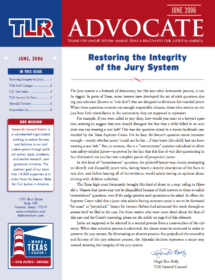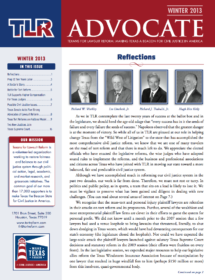Medical Liability
The Lone Star State’s population growth presents a number of challenges, including ensuring that Texans have access to healthcare. A key component of ensuring access to quality healthcare is having enough hospitals and doctors to provide care across the state.
In the past, access to healthcare was threatened in Texas because of an excessive number of unwarranted lawsuits against physicians and hospitals. The volume of lawsuits and the unpredictability of their outcomes caused doctors’ and hospitals’ liability insurance premiums to skyrocket. This high cost, along with the risk and stress of non-meritorious lawsuits, drove many physicians to leave Texas. The flight of physicians and other medical professionals from Texas was especially pronounced in high-risk specialties, like obstetrics, and in certain areas of the state, like south Texas and many rural areas.
Over the years, the Texas Legislature has enacted comprehensive and historic reforms to help doctors spend less time in the courtroom fighting unnecessary lawsuits and more time treating patients. At the same time, Texans can pursue legitimate cases against doctors and hospitals that cause harm through negligence or intentional misconduct.
The common-sense reforms enacted by the Legislature brought more predictability into the system, allowing medical liability insurance premiums to drop substantially, and helping attract doctors and other medical professionals to the state. As a result, Texas is now home to a robust medical community, including many world-class hospitals that have been able to expand patient services and develop innovative treatment programs. The work done by the Texas Legislature to guarantee access to healthcare is a national example of tort reform delivering on its promises and improving lives.
2021: Pandemic Liability Protections
As COVID-19 proved, pandemics are fluid situations that require everyone to adapt to changing guidance and protocols. Senate Bill 6 provides reasonable retroactive civil liability protections for businesses, religious institutions, non-profit entities, healthcare providers, first responders and educational institutions (see also Personal Injury, Wrongful Death and Other Torts).
The bill implements the following with regard to healthcare providers:
- Protections apply to care rendered to known or suspected COVID-19 patients and to care affected by the pandemic.
- Conduct is governed by gross negligence or a willful and wanton standard that mirrors Texas’ Good Samaritan law and emergency care protections. The bill does not provide unchecked liability protection; it simply broadens the current emergency room standard to COVID-19 patients and situations where the defendant proves that COVID-19 was the producing cause of the alleged negligent care.
- Liability protections are retroactive to March 13, 2020, when Gov. Abbott declared COVID-19 a public health emergency.
1995: A Step Toward Healthcare Liability Reform
The healthcare litigation reform movement took a large step forward during TLR’s first active legislative session in 1995, when the Legislature passed the common-sense measures in House Bill 971. Among other things, the statutes enacted by HB 971 require the plaintiff in a healthcare liability case to file an affidavit by a qualified physician detailing the specific acts or omissions alleged to have caused injury. The physician signing the affidavit must be qualified to offer the opinion based on his training and experience, and is required to base his opinion on accepted standards of medical care.
1999: Expanding the Good Samaritan Statute
In 1999, the Legislature passed Senate Bill 215, which expands Texas’ Good Samaritan statute to extend liability protection to doctors and other healthcare providers who donate time and talent to treat people who are unable to afford medical care. (See also Personal Injury.)
2003: Comprehensive Healthcare Liability Reform
By the early 2000s, it was clear that Texas still had work to do to restore fairness and balance to its medical liability system. Despite the requirements passed in HB 971, attorneys would often file affidavits that were obviously insufficient but were held to be “good enough” by trial courts that were willing to allow meritless lawsuits to proceed. Consequently, the Legislature passed comprehensive reforms in House Bill 4 of 2003. Among other things, the statute:
- Provides that a trial court’s decision on the sufficiency of a physician’s affidavit (as described in regard to HB 971 above) may be reviewed by a court of appeals immediately after the lawsuit is filed.
- Places limits on the noneconomic damages (such as pain and suffering) that a person can recover in a healthcare liability case (not all civil cases), based on a California statute that had been effective in reducing frivolous lawsuits against physicians and hospitals. The cap was set at:
- $250,000 per-claimant for all claims against physicians and nurses, and
- $250,000 per healthcare institution, subject to a $500,000 aggregate cap,
- resulting in a total possible recovery of $750,000 for noneconomic damages in a single healthcare liability case.
- Limits the personal liability of employees of government-operated healthcare facilities. Thus, physicians who contribute to the public good by working for a government-operated hospital have liability protection from a judgment against them personally.
- Provides additional limits on liability for nonprofit hospitals or systems that provide charity care and community benefits in their areas.
- Limits recovery of damages for healthcare expenses to those actually incurred by the plaintiff. Before this measure was enacted, Texas law allowed a plaintiff to recover as “actual damages” amounts that were never paid by the plaintiff or by anyone else on the plaintiff’s behalf.
- Allows the judge and jury to consider the impact of federal income taxes in awarding future damages to the plaintiff.
See also Damages, Personal Injury


